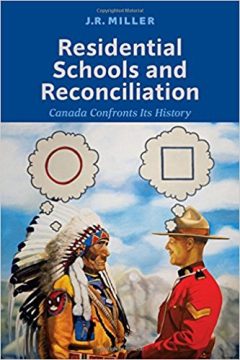In Canada’s tortured postwar history of “reconciliation” with Indigenous people not a single deputy minister has been called to the witness stand. That’s odd. There have been twenty of them since 1953, yet blame for repeated failures was pinned on churches, social workers, Indian Residential School superintendents, the police or Canadian society as a whole. When everybody is to blame, nobody is to blame.
Professor Jim Miller of the University of Saskatchewan pulls back the curtain on the historical blame game. Residential Schools And Reconciliation documents Ottawa’s handling of Indigenous issues. This is not ancient history. It just happened.
Methodically, step by step in infuriating detail, Miller recounts the costly failures, a “pettifogging” dispute resolution system and bureaucratic cross-piling of sawdust that left Canadians with a process that satisfied no one.
“It was easier to blame the students for the shortcomings of the schools than to face up to the reality that the system the Canadian government and the churches had created was not succeeding,” writes Miller.
The system began unraveling in 1993 when pedophile William Starr, former supervisor of an Indian Residential School at Gordon, Sask. northeast of Regina, was jailed for sexual assaulting students. Originally run by the Anglican Church, the Gordon School was taken over by the Department of Indian Affairs in 1969. This spelled federal liability. The Gordon facility was the last Residential School to close, in 1996.
Starr’s crimes triggered cascading disclosures that led to official apologies, hundreds of millions in payments to entrepreneurial law firms, compensation for students and a succession of inquiries that carefully avoided any direct connection to headquarters back in Ottawa.
The Department of Indian Affairs had “a long history of deciding things for rather than with First Nations people,” writes Miller. He recounts the experience of one civil servant, Shawn Tupper, assigned to the Residential School issue in 1996 following the Gordon scandal.
“The government’s position concerning the schools had evolved little over the previous half-century,” notes Residential Schools And Reconciliation. No one had even talked to students. Tupper thought it might be a good idea to go “into the field and talk to people who had been affected.”
Residential Schools And Reconciliation cites indelible vignettes. How should Ottawa and the churches split liability: fifty-fifty? Sixty-forty? Seventy-thirty? Should churches apologize or merely issue statements of repentance on advice of legal counsel?
How might officialdom handle degrading spectacles, where claimants for compensation would “have to answer questions about where the priest put his finger or penis, how many times, how they felt, and so on”? What if Indigenous boys and girls attended day school, not boarding school – did that count?
Through all of it, successive deputy ministers were held blameless. No names were named. Crimes were ascribed to an unfortunate colonial culture.
In the name of reconciliation, the Royal Winnipeg Ballet received a $50,000 grant “to help develop a new ballet that was based on the stories that had been recounted by survivors at the various meetings of the Truth and Reconciliation Commission.” It “enjoyed a short run”, writes Miller.
Not official reconciliation, however. This will be with us for a long, long time.
By Holly Doan
Residential Schools and Reconciliation: Canada Confronts Its History, by J.R. Miller; University of Toronto Press; 348 pages; ISBN 9781-4875-02188; $39.95






